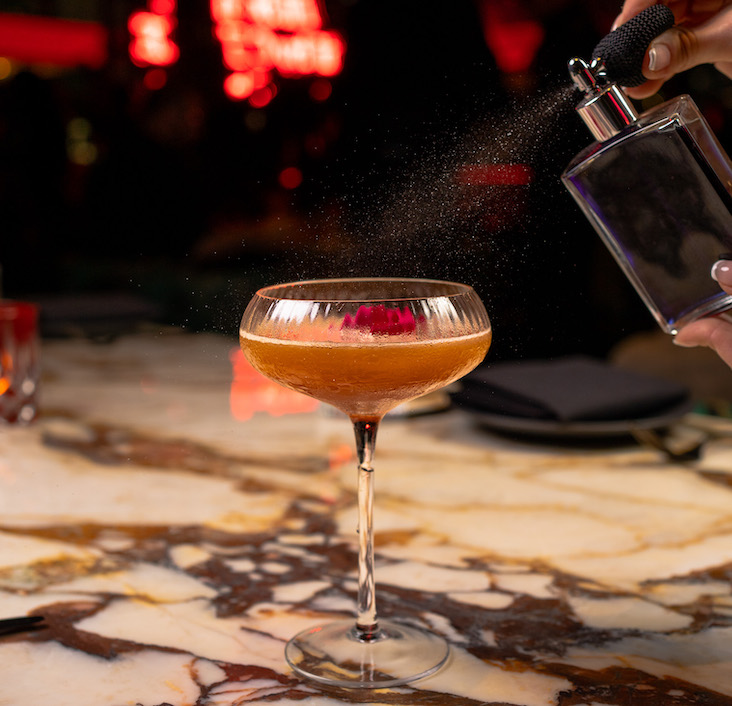In an effort to make her restaurant an oasis in the storm, Nahabedian made an investment this year by expanding the lounge menu and mignardise program—as well as redecorating and updating china and glassware—despite slower sales. It’s an approach Frank Bonnano, chef and owner of four Denver-area independent restaurants—Mizuna, Luca D’Italia, Osteria Marco and Bones—understands. “You stay true to what you do and just work harder and smarter to make things better,” he says.
But put “harder and smarter” chef efforts to source better-for-the-planet and better-tasting ingredients together with American’s desire for less stuffiness, and the look of luxury does change. Excess extravagance is out. Personalized, sincere, well-trained service is in. Old school luxuries like truffles, foie gras and caviar are still featured, but more reservedly so, making way for greater menu emphasis on more conscientious luxury foods: heirloom vegetables, locally grown produce, heritage-breed animals and house-made charcuterie, salumi and cheese.
As Chef Greg Biggers of Fulton’s on the River, a classic seafood and steak house from Levy Restaurants in Chicago, puts it: “In the past, people were forking out all kinds of money for foie gras. Today, they’re more likely to spend a little extra to be more eco-friendly and smart-food conscious.” In varying degrees, this is true across the fine-dining spectrum, from special occasion restaurants to the more approachable neighborhood places.
“We still serve foie gras and truffles, but there are other dishes that take a lot of time, effort and technique to prepare that our guests think are just as decadent, says chef Scott Gottlich at Bijoux, a special-occasion restaurant in Dallas with pre-fixe three- and five-course menus, priced at $58 and $72, respectively, and a nine-course tasting menu that costs $147 with wine and $97 without. Dishes that hit the high notes, he says, include “house-smoked and cured meats that take months and a lot of love, time and upkeep to prepare.”
At the Plumed Horse, in Saratoga, Calif., another high-end restaurant, owner Josh Weeks says guest counts are down but spending is not. The people that do come in still want to go all out for a luxury experience. “Truffles and traditional luxury ingredients are part of that, but people are also much more interested in where food is coming from,” says Weeks. “Is the meat farm-raised? Was the fish line-caught? Is this a heritage breed of pork? They are willing to pay the price for those things.”
Value Engineering
To get the greatest mileage out of expensive ingredients, most operators are creatively value-engineering their menus. Chef Ryan LaRoche’s foie gras crème brûlée at NoMI, a fine dining restaurant in the 198-room Park Hyatt Chicago, is a signature decadence that makes far more efficient usage of the traditional luxury ingredient. By combining the liver with custard cream, LaRoche is able to make sixteen crème brûlées with just one lobe of foie gras. That is double the number of appetizers that would be possible had he not innovatively made use of cream.
Talking truffles, LaRoche says he still uses black Périgord truffles, but in moderation. “We’re no longer shaving truffles tableside,” he says, “And we only use them in one dish.” Some operators are experimenting with less costly black summer and Oregon truffles. “We use the high-end truffles, but we’ve been playing with the others,” says chef Nathan Lockwood, of the accessibly elegant JORY restaurant at the 85-room Allison Inn & Spa, in Newberg, Ore. Most fine-dining chefs talk about “spreading the love around” a bit when it comes to their most expensive ingredients. “Now is not the time to put Copper River Sockeye Salmon, wild asparagus, spring morels and nettles all in the same dish.”
Whole Animal Approach
Purchasing a whole animal rather than individual cuts of meat may also be a value proposition for operators willing to put in the extra labor and time. “There’s a certain level of staffing you need to do this, but it makes sense to work with the whole animal rather than bringing in 10-ounce cryovaced tenderloins,” says Shaun Doty, of Shaun’s Restaurant, a bistro in Atlanta. Of course, some of the cost depends on the animal. Many high-end venues also are having heritage breeds of animals—such as Tamworth, Kurobuta, or Berkshire pigs—raised for them, which can be many times more expensive than non-heritage breeds.
By utilizing whole animals, many chefs have followed the lead of St. John restaurant in London, England, and many now take a nose-to-tail approach, creating charcuterie and serving plates that contrast various flavors and textures of meats. “At Luca d’Italia [in Denver], we’ve really honed in on our cheese and salumi program,” says Bonnano. “It started seven years ago when I started making my own salumi. We now have shares in goats and make robiola, bleu and ricotta cheeses from their milk. We’re also making buratta, mozzarella and taleggio cheeses.”
Bonnano says his chefs like the empowerment that comes from purchasing their foods from farmers. One cook sources ingredients from a chicken farmer that range from eggs to chicken livers. “We’re making beautiful pâtés with their livers instead of foie gras,” Bonnano explains. In fact, he says the more flavorful chicken liver pâté has replaced foie gras in a ravioli dish, and it’s now priced at $14, instead of $26.
More Meaty Solutions
As a less costly alternative to beef tenderloin, chef John Newman of Newmans at 988 in Cannon Beach, Ore., creates petite tenders from beef shoulder, which he trims, sears and roasts. It’s served with local Oregon gorgonzola, pancetta, polenta and organic roasted tomato and spinach. Guests love the dish, which is priced at $22 compared with the $29 tenderloin.
Meanwhile, at Luca d’Italia, which has always been an aged New York-strip type of place, the runaway success of a new $32 Snake River Farms hangar steak has been a surprise. “We put it on the menu a few months ago and it’s become the best-selling steak on the menu. It’s a better value than other filets, and people like the flavor even though it’s a lesser-known cut,” says Bonnano.
And at David Burke’s Primehouse, a fine-dining steakhouse at the 297-room James Hotel in Chicago, executive chef Rick Gresh applies the same dry-aging techniques to beef shoulder meat that he does to fancy filets. As a result, “the $12 hamburgers we make from the shoulder have the same flavor of our $50 steaks,” says Gresh. Taking dry-aging one step further, Gresh is also dry-aging Kobe beef shoulder chunks to make luxurious bologna.
Equally unexpected, in addition to making charcuterie from whole pigs, chef Sam Burman at contemporary American restaurant bluprint in Chicago brines the hams for eight days to make corned pork—rather than beef—reuben sandwiches. Sliced thin, the ham is served with sauerkraut made from heirloom cabbage, locally produced swiss cheese and house made sweet-pickle dressing on dark rye bread for $12.
Simple Goodness, Setting and Service
In skillful hands, simple ingredients can also have a luxury appeal. Hoss Zaré, the chef and owner of Zaré at Fly Trap, a contemporary Persian restaurant in San Francisco, says items such as his house-made sun-dried yogurt, fresh walnuts in season and fresh turmeric—instead of prohibitively expensive saffron—can elevate the dishes.
Likewise, simple but exotic in their unfamiliarity, heirloom varietal vegetables get their due at bluprint in Chicago. At dinner, for $17, the Skirt Steak entrée is served with heirloom Rose Finn Apple herb-roasted potatoes, Spanish chorizo and heirloom pimiento-roasted peppers when in season. “Lettuce, beans, potatoes and so on… We’ve educated our guests that heirloom goes beyond tomato!” says Burman.
“People want that uniqueness,” says John des Rosiers of Inovasi restaurant, a fine dining restaurant in Lake Bluff, Illinois. “Difficult to find, hard to obtain vegetables are interesting to people—especially if you’re growing them locally.” As an example, although it took him two months to find the seeds in France, des Rosiers will be working with a local farmer to grow white romaine lettuce this year.
Beyond food, the current thought on atmosphere and service also is intriguing. It was once only possible to get high-end ingredient preparations in fine dining establishments complete with Frette linens. Today, a new breed of restaurant food luxury is proliferating where trappings take a back seat to the food. Witness Daniel Patterson and Lauren Kino’s Il Cane Rosso, a trend-setting, limited-service restaurant in San Francisco. In order to sell sandwiches such as its Long & Bailey’s Porchetta dandelion greens for $9, Il Cane Rosso’s daily changing menus are written on butcher paper and food is ordered from a counter.
But most fine-food purveyors prefer to keep the service, setting and food triad more balanced. In fact, most say that as fine dining becomes more casual, impeccable service has never been more crucial. “You want to be careful not to diminish what you do to the point that you’re sending a mixed message to the guest,” cautions Doty. Bonnano adds that, “even at my more casual places, where servers are in T-shirts, they remove every piece of silver when a course is completed.” When servers deliver food, they also describe it from the bottom up before leaving.
Such attention to detail generates more revenue for staff as well as for owners. “We’ll cut inventory on wine and food, but never training,” says Mario Nocifera, manager of Zaré. “People’s expectations are so high right now. It’s of utmost importance that we provide great, well-informed service that is non-ego [driven] and non-intrusive, but encourages people to feel comfortable.” Carol Wallach, the chef and owner of Chicago’s Sola, a contemporary American restaurant, agrees. “Fine dining service is in the details: little things, small touches like providing purse hooks, shawls for women sitting on the terrace when it gets cool—those little things speak volumes and make luxury tangible.”
Details like that are especially important as more fine dining chefs open small, neighborhood restaurants where the trappings take a back seat to fresh, seasonal, well-composed and un-fussy dishes. “Look around you. When you talk about redefining luxury, that’s truly where the whole thing’s headed,” Bonnano concludes.



